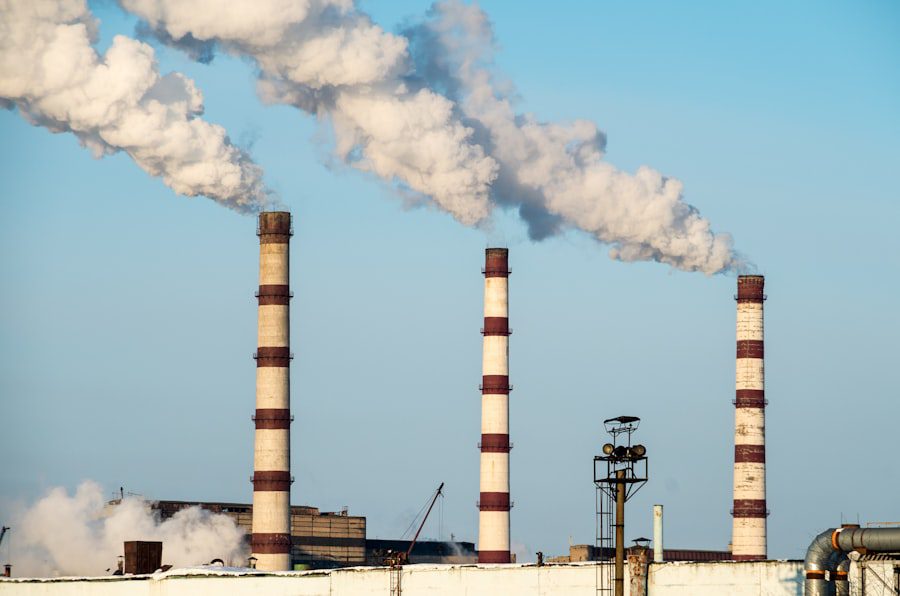Coal has been used as a source of energy for centuries, with the earliest known use dating back to ancient China. Over time, coal technology has evolved significantly, from the simple burning of coal for heat and light to the development of advanced coal-fired power plants. In the 18th and 19th centuries, the Industrial Revolution saw a rapid expansion in the use of coal as a primary source of energy for steam engines and later for electricity generation. This led to the development of more efficient coal mining techniques and the construction of larger and more powerful coal-fired power plants.
In the 20th century, advancements in coal technology continued with the introduction of technologies such as pulverized coal combustion, fluidized bed combustion, and integrated gasification combined cycle (IGCC) plants. These technologies improved the efficiency of coal-fired power plants and reduced their environmental impact. More recently, research and development efforts have focused on advanced coal technologies such as carbon capture and storage (CCS) and coal gasification, which have the potential to further reduce emissions and make coal a more sustainable energy source.
Key Takeaways
- Coal technology has evolved over time, from traditional methods to advanced sustainable solutions.
- Traditional coal power has significant environmental impacts, including air and water pollution and greenhouse gas emissions.
- Advanced coal technology offers a more sustainable solution, with lower emissions and improved efficiency.
- The benefits of advanced coal technology include reduced environmental impact, increased energy security, and economic growth.
- Advanced coal technology can play a role in the energy transition by providing a reliable and sustainable source of power while renewable energy sources continue to develop.
The Environmental Impact of Traditional Coal Power
While coal has been a reliable and affordable source of energy, traditional coal-fired power plants have had a significant impact on the environment. The burning of coal releases large amounts of carbon dioxide (CO2) and other greenhouse gases into the atmosphere, contributing to climate change. In addition, coal combustion produces air pollutants such as sulfur dioxide (SO2), nitrogen oxides (NOx), and particulate matter, which can have detrimental effects on human health and the environment.
Coal mining also has environmental impacts, including habitat destruction, water pollution, and the release of methane, a potent greenhouse gas. The disposal of coal ash, a byproduct of coal combustion, has also raised concerns due to its potential to contaminate water sources and harm ecosystems. These environmental impacts have led to calls for the phase-out of traditional coal power in favor of cleaner energy sources. However, with the development of advanced coal technology, there is potential to mitigate these impacts and make coal a more sustainable energy option.
Advanced Coal Technology: A Sustainable Solution
Advanced coal technology offers a sustainable solution to the environmental challenges associated with traditional coal power. One key advancement is carbon capture and storage (CCS), which involves capturing CO2 emissions from power plants and storing them underground to prevent their release into the atmosphere. CCS has the potential to significantly reduce CO2 emissions from coal-fired power plants, making them more environmentally friendly.
Another advanced coal technology is coal gasification, which converts coal into a synthetic gas that can be used for power generation or as a feedstock for producing chemicals and fuels. This process is more efficient than traditional coal combustion and produces fewer emissions, making it a cleaner alternative. Additionally, integrated gasification combined cycle (IGCC) plants combine coal gasification with a gas turbine system to further improve efficiency and reduce emissions.
The Benefits of Advanced Coal Technology
| Benefits | Advanced Coal Technology |
|---|---|
| Reduced Emissions | Advanced coal technology can significantly reduce emissions of sulfur dioxide, nitrogen oxides, and particulate matter compared to traditional coal-fired power plants. |
| Increased Efficiency | New coal technologies can achieve higher efficiency in converting coal into electricity, leading to lower fuel consumption and reduced greenhouse gas emissions. |
| Carbon Capture and Storage | Advanced coal technology allows for the capture and storage of carbon dioxide emissions, helping to mitigate the impact of coal-fired power generation on climate change. |
| Improved Flexibility | New coal technologies offer greater flexibility in responding to changes in electricity demand and integrating renewable energy sources into the power grid. |
Advanced coal technology offers several benefits compared to traditional coal power. One of the main advantages is its potential to reduce greenhouse gas emissions and mitigate climate change. By capturing and storing CO2 emissions, advanced coal technology can help to lower the carbon footprint of coal-fired power plants, making them more compatible with global efforts to reduce emissions.
In addition to environmental benefits, advanced coal technology can also improve energy security by utilizing domestic coal reserves more efficiently. This reduces reliance on imported energy sources and helps to stabilize energy prices. Furthermore, advanced coal technology can create new economic opportunities through the development of innovative technologies and the establishment of new industries focused on carbon capture, utilization, and storage (CCUS).
The Role of Advanced Coal Technology in Energy Transition
As the world transitions towards a low-carbon energy future, advanced coal technology can play a crucial role in providing a bridge between traditional coal power and cleaner energy sources. While renewable energy technologies such as solar and wind are rapidly expanding, they are not yet capable of meeting all energy demand on their own. Advanced coal technology can help to fill this gap by providing a reliable and flexible source of baseload power while reducing emissions.
Furthermore, advanced coal technology can complement renewable energy sources by providing backup power during periods of low renewable energy generation. This can help to ensure grid stability and reliability as the share of renewable energy in the electricity mix continues to grow. By integrating advanced coal technology with renewable energy, it is possible to achieve a more balanced and sustainable energy system.
Challenges and Opportunities in Implementing Advanced Coal Technology

While advanced coal technology offers promising solutions to environmental challenges, there are still several challenges that need to be addressed in its implementation. One major challenge is the high cost of deploying advanced coal technologies, particularly carbon capture and storage (CCS). The construction and operation of CCS facilities require significant investment, which can make them less competitive compared to other energy options.
Another challenge is public perception and acceptance of advanced coal technology. Despite its potential environmental benefits, there is still skepticism and opposition towards coal as an energy source due to its historical environmental impact. Overcoming these perceptions will require effective communication and education about the advancements in coal technology and their potential to address environmental concerns.
However, there are also opportunities in implementing advanced coal technology. Research and development efforts continue to drive innovation in this field, leading to improvements in efficiency and cost reduction. Collaboration between governments, industry, and research institutions can help to accelerate the deployment of advanced coal technologies and create a supportive policy environment.
The Future of Energy: Advanced Coal Technology’s Potential
In conclusion, advanced coal technology has the potential to play a significant role in the future of energy as the world seeks to transition towards a low-carbon economy. By addressing the environmental impacts of traditional coal power through technologies such as carbon capture and storage (CCS) and coal gasification, advanced coal technology can offer a sustainable solution that complements renewable energy sources.
While there are challenges in implementing advanced coal technology, such as high costs and public perception, there are also opportunities for innovation and collaboration that can drive its adoption. As advancements in coal technology continue to evolve, it is possible for coal to remain a viable part of the energy mix while contributing to global efforts to reduce emissions and combat climate change.
Overall, advanced coal technology represents a promising pathway towards a more sustainable and balanced energy system that meets both environmental and energy security goals. With continued investment and support, advanced coal technology can contribute to a cleaner energy future while leveraging the abundant global reserves of coal.
If you’re interested in learning more about the advancements in coal technology, you should check out this article about the top Afghan coal plant leading the way in processing. It provides valuable insights into how coal is being revolutionized in Afghanistan and the impact it could have on the energy industry.
FAQs
What is advanced coal technology?
Advanced coal technology refers to the use of innovative and efficient methods to extract, process, and utilize coal for energy production. This includes technologies such as carbon capture and storage (CCS), integrated gasification combined cycle (IGCC), and supercritical and ultra-supercritical coal-fired power plants.
What are the benefits of advanced coal technology?
Advanced coal technology offers several benefits, including increased efficiency in coal-fired power plants, reduced emissions of pollutants such as sulfur dioxide and nitrogen oxides, and the potential for capturing and storing carbon dioxide to mitigate climate change.
How does carbon capture and storage (CCS) work in advanced coal technology?
Carbon capture and storage (CCS) involves capturing carbon dioxide emissions from coal-fired power plants and other industrial processes, transporting the CO2 to a storage site, and injecting it deep underground for long-term storage. This technology helps to reduce greenhouse gas emissions from coal-based energy production.
What is integrated gasification combined cycle (IGCC) in advanced coal technology?
Integrated gasification combined cycle (IGCC) is a technology that converts coal into a synthesis gas (syngas) through a gasification process. The syngas is then used to generate electricity in a combined cycle power plant, resulting in higher efficiency and lower emissions compared to traditional coal-fired power plants.
What are supercritical and ultra-supercritical coal-fired power plants?
Supercritical and ultra-supercritical coal-fired power plants operate at higher temperatures and pressures, resulting in increased efficiency and lower emissions compared to subcritical power plants. These advanced coal technologies help to reduce the environmental impact of coal-based energy production.



